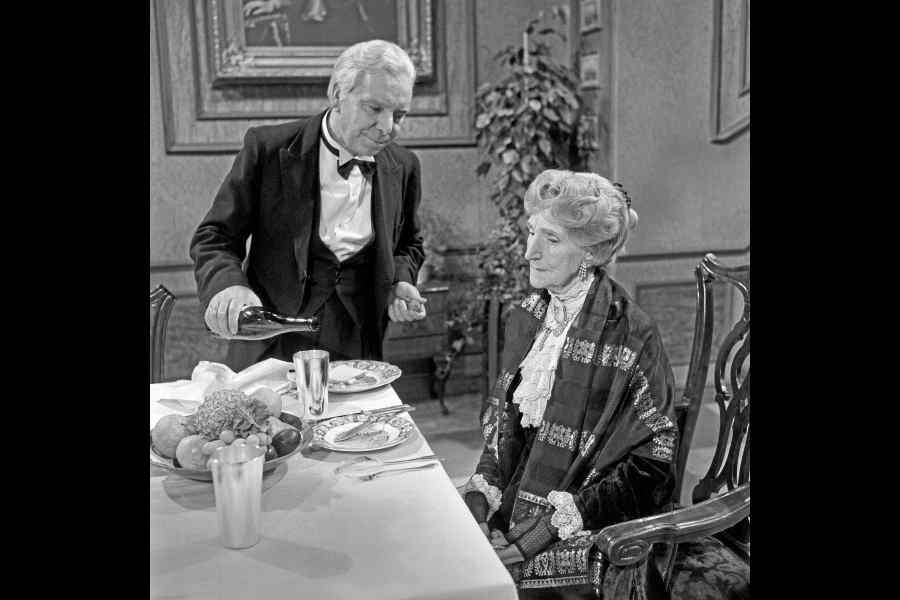Every New Year’s eve across Germany, families huddle around televisions to take delight in watching an obscure British sketch called Dinner for One (1963). But the comedy is hardly obscure in Germany. Ask any German and he/she will immediately know about the skit and would often be able to recite the bit line for line. In between programmes that present the year in review or broadcasts from the chancellor, watching this sketch has been a beloved German New Year’s tradition since 1972. According to the Guinness Book of World Records, the sketch is the most-repeated television programme ever, even though it only aired for the first time in the United Kingdom in 2018. Although it is presented almost entirely in English, much of the anglophone world is unaware of its existence, let alone of its popularity.
In the original television broadcast shot in black and white, a short introduction in German explains that the elderly Miss Sophie entertains her four closest friends for her birthday every year. The sketch opens with the table being set by her dutiful butler, James, and places being laid for Sir Toby, Mr Pommeroy, Mr Winterbottom, and Admiral von Schneider, conveniently ignoring the fact that each guest is long deceased and, so, the places are kept empty. As James sets the table, he asks Miss Sophie the oft-repeated catchphrase of the sketch: “The same procedure as last year, madam?” To which she always replies, “The same procedure as every year, James.” As the dinner party continues, James playacts each of the guests to appease Miss Sophie while serving food and drinks to each of them. He toasts imitating each missing guest, including von Schneider who toasts with a very Prussian military heel kick (James injures himself while performing this) and a hearty Scandinavian “Skol!” James totters back and forth, repeatedly tripping over the head of a tiger pelt rug as he serves mulligatawny soup and becomes increasingly, visibly, sloshed as he drinks each drink poured for the four guests over four courses. Each course repeats the procedural question while confirming an obedient commitment to tradition. The skit ends with James’ final commitment to the ‘procedure’ — which is taking the old Miss Sophie off to bed with a drunken wink and an insinuating promise to “do [his] very best.”
Dinner for One, also known as Der 90 Geburtstag (The 90th Birthday), first originated as a cabaret sketch in 1920s’ Britain. It was written by Lauri Wylie for the stage. Upon discovery by the German entertainer, Peter Frankenfeld, in Blackpool, England, in 1963, the British comedians, Freddie Frinton and May Warden, were invited by Frankenfeld to perform the sketch in front of a live Hamburg audience. The film’s 18-minute run time is short and sweet and was a convenient way to fill airtime between larger broadcasts. It is still aired every year across the country by the Hamburg-based television network, Norddeutscher Rundfunk.
For Germans, this sketch has become synonymous with British humour as well as with a bygone era of tradition. In an article in The Guardian on the phenomenon that is Dinner for One, Stefanie Bolzen writes, “Germans still have a stereotypical idea of British society being divided by class, with an establishment made up of eccentric individuals lost in a forlorn past.” But many of its unsavoury references to British colonialism go unnoticed by Germans — a feature that may be part of the reason why the sketch never quite caught on in its home country. The tiger skin rug, in particular, acts as a key comedic device, repeatedly tripping the hapless butler, James. Many a Briton may read this as an unmistakable relic of big game trophy hunting during Britain’s colonial rule if India. All that’s missing is a pith helmet and a Brown Bess musket. The serving of mulligatawny soup is a more subtle reference; having originated in Tamil Nadu, the dish has since become a mainstay of British cuisine. Much of this colonial reference is lost on most Germans who have a limited relationship with British colonialism and with the colonial period in general despite German attempts — they failed — to create colonial outposts in Africa and Asia.
There are innumerable permutations of Dinner for One, from a colourised version to a puppet version for children called Dinner für Brot (Dinner for Bread). There are cookbooks, theme restaurants, and even a commemorative stamp inspired by the show. German fans have variable ways of celebrating the comedy each year, from replicating the dinner served to emulating James’ tippling in the form of a drinking game. According to one German I spoke to, Dinner for One’s popularity can be neatly attributed to the sketch being “about alcohol, and [Germans] all like to get drunk.” But it might be more than that. New Year’s parties, or parties in general, often fail to meet ambitious expectations. “No matter how many people we meet, there’s never enough for a party. Dinner for One is a party for 2 thanks to the butler’s antics,” one viewer explained to me. Or maybe the tradition is a fond memorial for friends and family who can no longer join us for the celebrations we cherished with them — a kind of “Auld Lang Syne”.
The popularity of Dinner for One may be best understood as a simple affinity for tradition. Repetition is the main comedic mechanism and the sketch itself is in many ways about repetition. The same slapstick jokes are played throughout, varied by the butler’s increasing drunkenness — the tripping over the tiger skin rug, the toasts of each imaginary character at the table, the famous call and response between James and Miss Sophie about honouring the “same procedure every year.”
There is something charming about the predictability of the humour, which is evident early on in this short comedic work. No matter how chaotic our years are, it is comforting to know that there will always be the same procedure. Every year.
Carol Schaeffer is a journalist based in New York and Berlin from where she writes about Europe, politics and culture











